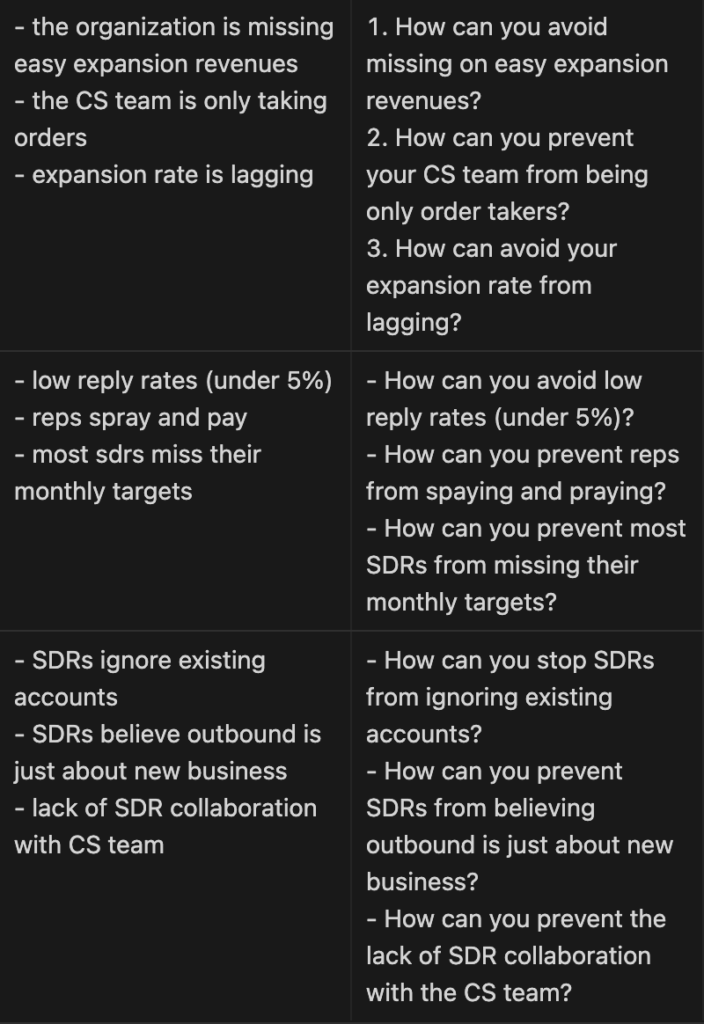5 steps to creating prospect curiosity
In today’s newsletter, I’m going to share my 5 steps to creating prospect curiosity in your cold outreach.
If you can replicate this process, you’re going to catch the attention of your prospects and get them to stop in their tracks to learn more about what you can do for them.
Unfortunately, most SDRs don’t have a solid understanding of what motivates prospects to reply, so they keep sending the same, product-oriented messages, and being ignored.
Creating curiosity gets prospects to keep reading your messages.
Without curiosity-inducing elements in your messages, there are a number of problems that arise:
Problem 1: Your message doesn’t stand out. Prospects quickly dismiss your outreach.
Problem 2: Prospects only scan your message. Your message isn’t even fully read.
Problem 3: Your message gets ignored. As a result, prospects move on and keep doing what they were doing before.
You can overcome all of these problems by creating curiosity-inducing elements in your cold outreach.
Here’s how I do it, step-by-step:
Step 1: Understand their problems
In a previous newsletter, I share my 3-step process to understanding your prospects’ problems.
In short, this is what you need to do:
Understand their goals and metrics
Find their initiatives and the problems they face
Study the exact symptoms of these problems and highlight them
Once you’re done with these 3 steps, you’ll have a better understanding of what keeps your prospects awake at night, and you’ll be able to put yourself in their shoes.
Step 2: List existing resources
Now that you know what problems your prospects are facing, you can start listing resources to solve these problems.
If your marketing colleagues are doing a good job, they should have plenty of content available to address these problems. They often have eBooks, whitepapers, long-form blog posts, podcasts/webinars.
For example, my customer at SeedLegals help founders raise money faster.
They know founders face difficulties raising money in an economic downturn, so they have created a long-form blog post.
Here are some places where you can look for resources:
your website resource page
LinkedIn/Twitter from a thought-leader targeting your ICP
partner website
Step 3: Build a resource plan
Now that you have a list of resources that can be used to help solve your prospects’ problems, you need to do a bit of curation.
If you share a long-form post or a 45-minute podcast in your cold outreach, prospects will ignore you. No one has time to go through these resources, without knowing what they’ll get as a result.
You can curate the resources you have listed by summarizing the top 3 – 5 points of the resources. Here’s an example with SeedLegals post:

Now I have a clear problem and symptoms, as well as curated resources.
Step 4: Shoot a teaser video
If you paid attention, you now have an outline for a teaser video on the specific problem you have identified. You can build the script of your video as follow:
Problem: {ICP problem} -> Founders cannot raise seed funding
Symptoms: {symptoms list} -> VCs do not reply, ask for seats at the board, and for bigger shares and smaller amounts of money
Resource: {resource name} -> How to fundraise in an economic downturn
Resource Plan: {key points} -> Understand how interest rates change investor behaviour, reduce burn rate, use agile funding
CTA: {link to resource + meeting link}
You can then record your teaser video with a video recording tool. I use Tolstoy to record my video.
Step 5: Tease the video
Finally, the last step to creating prospect curiosity is teasing the video in your cold outreach. I have written a full guide on my 4-step prospecting framework, but here’s how it looks like:
Trigger: A relevant piece of information about my prospect -> Mary, noticed you liked John’s 5-steps to raising seed funding in 2022.
Question: A problem-oriented question -> How are you avoiding wasting your time with VCs who ask more shares for the same amount of money?
Teaser: A mention of the resource in step 4 -> If you’re interested, I have a short video on what you can do to raise money in a downturn.
CTA: A close-ended question -> Interested in grabbing it?
If you have identified problems that are really relevant to your prospects, following these 5 steps will help create curiosity, and you’ll start more conversations as a result.
TL;DR:
Step 1: Understand their problems
Step 2: List existing resources
Step 3: Build a resource plan
Step 4: Shoot a teaser video
Step 5: Tease the video
Cheers,
Thibaut
- Build your outbound prospecting system from scratch here (200+ students)
- (NEW!) Write cold messages that get a 38% reply rate and 27% meeting rate here (20+)
- Book me 1:1 or for your team here
- (NEW!) Sponsor my newsletter & get 3k+ eyeballs on your ad!
Subscribe to the Newsletter
Get my free, 4 min weekly newsletter. Used by 5.900+ salespeople to book more meetings and work when, where, and how they want.
Subscribe to the Newsletter
Get my free, 4 min weekly newsletter. Used by 5.900+ salespeople to book more meetings and work when, where, and how they want.



